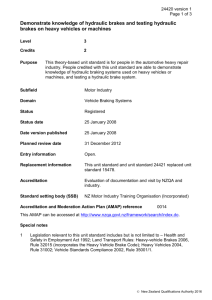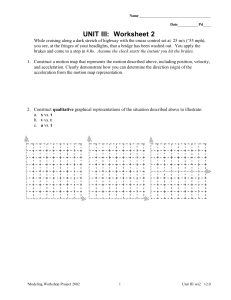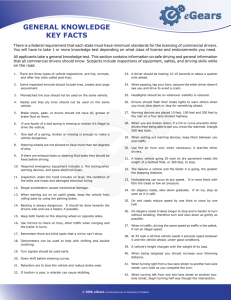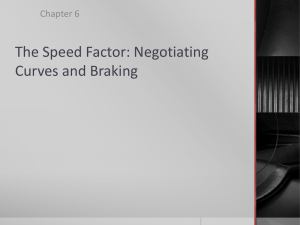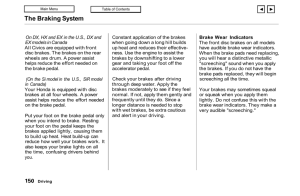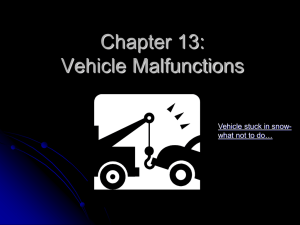Heavy vehicle braking–part 3
advertisement
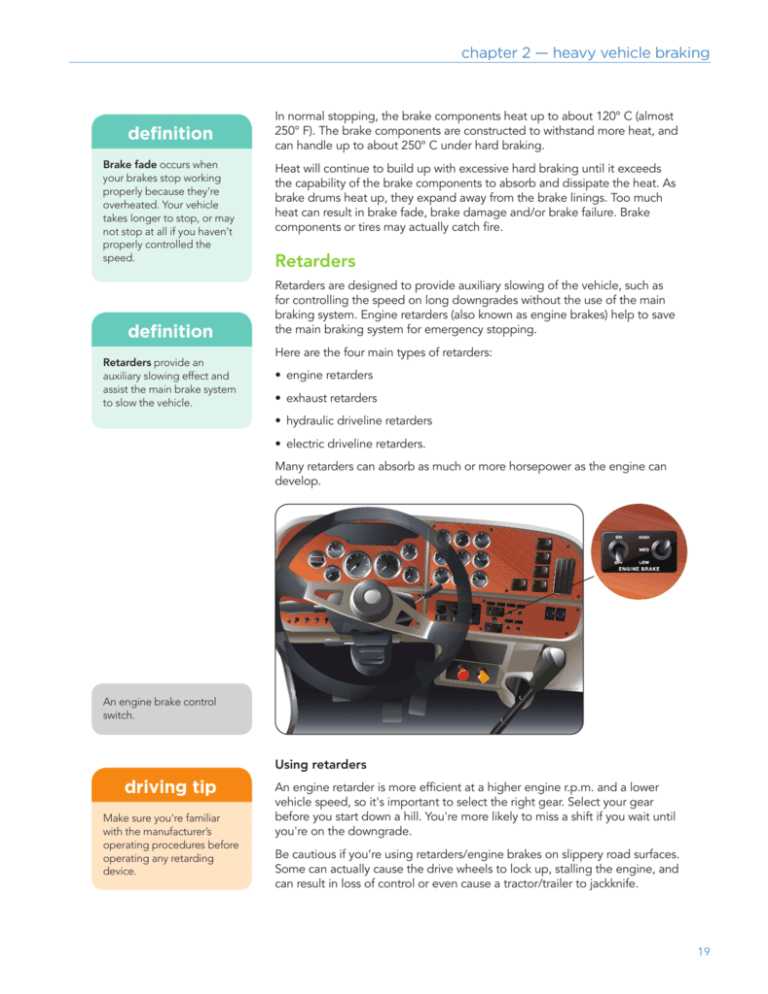
chapter 2 — heavy vehicle braking definition Brake fade occurs when your brakes stop working properly because they're overheated. Your vehicle takes longer to stop, or may not stop at all if you haven't properly controlled the speed. definition Retarders provide an auxiliary slowing effect and assist the main brake system to slow the vehicle. In normal stopping, the brake components heat up to about 120° C (almost 250° F). The brake components are constructed to withstand more heat, and can handle up to about 250° C under hard braking. Heat will continue to build up with excessive hard braking until it exceeds the capability of the brake components to absorb and dissipate the heat. As brake drums heat up, they expand away from the brake linings. Too much heat can result in brake fade, brake damage and/or brake failure. Brake components or tires may actually catch fire. Retarders Retarders are designed to provide auxiliary slowing of the vehicle, such as for controlling the speed on long downgrades without the use of the main braking system. Engine retarders (also known as engine brakes) help to save the main braking system for emergency stopping. Here are the four main types of retarders: • engine retarders • exhaust retarders • hydraulic driveline retarders • electric driveline retarders. Many retarders can absorb as much or more horsepower as the engine can develop. An engine brake control switch. Using retarders driving tip Make sure you're familiar with the manufacturer’s operating procedures before operating any retarding device. An engine retarder is more efficient at a higher engine r.p.m. and a lower vehicle speed, so it's important to select the right gear. Select your gear before you start down a hill. You're more likely to miss a shift if you wait until you're on the downgrade. Be cautious if you’re using retarders/engine brakes on slippery road surfaces. Some can actually cause the drive wheels to lock up, stalling the engine, and can result in loss of control or even cause a tractor/trailer to jackknife. 19 driving commercial vehicles definition The term r.p.m. stands for revolutions per minute. This refers to the number of complete turns the crankshaft makes in one minute. Most trucks have a tachometer in the instrument panel to indicate the engine’s r.p.m. fast fact You can be fined if you are operating a vehicle with brakes that are not adjusted correctly or not performing adequately. All modern trucks are manufactured to meet safety standards, including noise levels. A well-engineered truck with an engine retarder and a properly maintained muffler system shouldn't be noisy. Many municipalities post signs restricting drivers from using engine retarders/engine brakes. Obey these signs. Braking Bringing your vehicle to a stop on a level roadway usually means squeezing gradually and firmly on the brake pedal with your foot. But sometimes you may have to react more quickly. Just before your vehicle comes to a full stop, reduce the pressure you're placing on the brake pedal. This will prevent your vehicle from jerking back. Practise stopping until you become familiar with how much pressure you need to ease off the brake to smoothly stop where you want. Watch the driving technique of the driver ahead. If the driver in front of you is a tailgater, expect frequent panic stops. Professional drivers maintain a safe following distance and plan for gradual stops. By making your stops slowly you give the driver behind you plenty of notice that you're reducing your speed. To stop safely, ensure that your brakes are correctly adjusted, your load is balanced and your tires are in good condition. Also, be certain that your tires are properly inflated. To ensure a smooth, controlled stop every time: • travel at a speed that allows you to see a safe distance ahead • maintain a safe following time or distance • use good braking skills. Icy roads driving tip Don’t wait until you spin out on a hill to put on the tire chains. It's extremely difficult to mount chains when you are on a hill. Instead, use a designated chain-up area. To stop on icy roads, use extremely light pressure on the brake to control your vehicle’s speed. This will help prevent the wheels from locking up. A slowly revolving wheel on an icy surface will be more effective than a locked wheel skidding on an icy surface. Vehicles equipped with anti-lock braking systems (ABS) will require a different technique for braking on an icy road surface, as shown later in this chapter. You need snow tires and/or chains on icy roads. Many highways have designated chain-up areas to allow you to mount chains before getting onto steep hills. Make sure you're familiar with how to mount chains on tires — practise mounting them before you find yourself in conditions where you need to put them on your vehicle. CHAIN UP AREA E X IT Make sure tire chains are properly sized for your tires and tightly mounted (don't deflate tires to install tire chains). Stop and check tire chain tightness at the first safe opportunity. Reduce speed when driving with tire chains. In extremely bad conditions, parking your vehicle may be safer than driving. Check weather and road conditions before you encounter icy roads. 20 chapter 2 — heavy vehicle braking fast fact Frequent use of the service brakes will cause them to heat up and reduce their stopping ability. The result can be a dangerous condition called brake fade. Downgrades There’s a limit to the amount of heat that brakes can absorb and dissipate. The highest brake temperatures occur when braking from highway speeds while on long downgrades, or from repeated use of the brakes without enough cooling time between applications. Almost all brake failures and downhill runaway crashes are caused by overdriving the ability of the brakes to deal with heat. In other words, poor speed control. Whether in town or on a highway, you’ll usually need to descend a hill more slowly than other traffic in order to avoid overdriving your brakes. You should be in a lower gear to go down the hill than used to climb it. Never shift to a higher gear on a downgrade unless the speed on the grade can be controlled with a retarding device or engine compression. On highways Truck advisory speed limits are often posted. Follow these speed limits. Use your four-way flashers to alert other drivers that you're driving slowly down the hill. Stay in the far right lane where possible. Control your speed all the way down every hill so you can respond to any emergency. Some steep hill warning signs show the steepness of the grade. The higher the percentage, the steeper the hill. This hill has an 18 per cent gradient, which is very steep. Select a safe speed that's not too fast for the weight of your vehicle, length, and steepness of the grade, weather, and road conditions. Use an appropriate low gear to hold that speed, and use the vehicle’s retarding device. If you've selected an appropriate safe speed, are in the right low gear and are using your vehicle’s retarding device, you should be able to go down the hill without using the service brakes. fast fact Engine retarders are most effective at a higher r.p.m. and with the transmission in a low gear. Save your brakes so you'll be able to stop if road and traffic conditions require their use. fast fact Always obey the regulatory stop and check brakes signs. These signs, showing special instructions for commercial vehicles, may be placed before a downhill grade. The one in the top left corner shows the speed suggested for descending the grade. The other signs direct you to check your brakes. If this doesn’t control your speed, and speed is increasing above your chosen speed: • apply the brakes hard enough to reduce speed by 10 to 15 km/h — the brakes are cold at this point • downshift to a lower main gear (don’t use the splitter valve for shifting on a downhill). 21 driving commercial vehicles Continue down the grade, using engine compression, transmission gearing and your vehicle’s retarding device to control your speed. If the speed increases again, repeat this process. Be careful using this procedure on icy roads. Keep your vehicle in gear all the way down the hill. In town • select a safe speed that's not too fast for the weight of your vehicle, length, and steepness of the grade, weather and road conditions • select an appropriate low gear to hold that speed • use the vehicle’s retarding device unless signs prohibit their use. You must control the speed of your vehicle so it can be stopped at any time for any emergency while descending a hill. Water on roadways Water can reduce braking efficiency. Avoid driving through large amounts of water whenever possible. If you have to drive through water on the roadway, cover the brake pedal with your foot as you approach the water. Place a slight drag (that is, apply a slight constant pressure) on the brakes while you drive through the water. The slight drag placed on the brakes will reduce the amount of water entering the brake drums and shoes. Always reduce your vehicle’s speed before driving through large pools of water on the roadway. During extremely wet conditions, or after driving through water, test your brakes by applying a slight pressure with your foot on the brake pedal. Keep this pressure on for a short distance to dry out the brakes. These two road signs alert you to runaway lanes. Runaway lanes Runaway lanes are located beside the road on some downhill grades. These lanes are there to help slow and stop vehicles if their brakes fail as they are going downhill. Runaway lanes should be used only to control your speed or stop. These lanes are there for safety. Don't use them for any other purpose. This sign is posted in advance of a runaway lane. Combination unit braking When you step on the brake pedal of a vehicle with air brakes, all of the brakes apply at the same time and at the same pressure. Trailers equipped with electric or vacuum brakes work in a similar way. This sign is found at the entrance to a runaway lane. Applying brake pressure too forcefully or only applying the trailer brakes on slippery roads may cause the wheels to lock up, which can result in a skid or jackknife. Use extra caution when applying brakes in a curve. Remember that the brakes, tires and suspension of a combination vehicle work best when the vehicle is legally loaded and the load is properly distributed among axles. When the cargo area is empty and there's no ABS, the vehicle’s wheels may bounce and lock up. This can make braking more difficult and increase your stopping distance. 22 chapter 2 — heavy vehicle braking You need to take extra care to safely tow two trailers. It can be difficult in an emergency to stop a multiple trailer combination in a straight line. In bad weather, slippery conditions and mountain driving, the risk of skidding and loss of traction increases. Look far ahead, leave plenty of following distance, and slow down to help avoid having to make emergency stops. Anti-lock braking systems Anti-lock braking systems (ABS) are mandatory in Canada on all trucks and buses over 4,560 kg manufactured since April 1, 2000 and on all commercial trailers equipped with air brakes. ABS is an addition to a normal air brake system. It helps prevent wheel lockup or skids caused by overbraking on slippery road surfaces. Contrary to what many people believe, ABS doesn't allow you to drive faster or stop sooner. In fact, on some surfaces such as gravel, the braking distance needed with ABS may be longer. ABS can help prevent wheel lock-up on surfaces where conventional brakes usually lock up, including slippery surfaces. This means you can brake hard without skidding and losing steering control. ABS may also help you prevent your vehicle from jackknifing. ABS is only as good as the driver. Learn the correct technique and practise it so that you're ready in an emergency. Read the manual from your vehicle manufacturer to learn how to use your ABS properly. definition A full jackknife occurs when a tractor and the trailer form an angle of 90 degrees or less, relative to one another. Warning: this can happen even at very low speeds. Jackknifing is often caused by poor braking techniques, including improper use of retarders. A fully jackknifed tractor/ trailer combination. 23 driving commercial vehicles driving tip It’s a good idea to practise using ABS so that you're familiar with how it works and feels. A few tips for emergency stopping with ABS: • Apply firm, hard continuous pressure to the brake pedal until the vehicle stops. • Don’t pump the brakes — this turns the system on and off. • Don’t be alarmed by brake noise, pedal movement or shudder. This is normal. Keep applying firm pressure. • Be extremely cautious when steering around obstacles. Remember that steering and handling characteristics will be affected by the size and load of the vehicle you're driving, and by the trailer you may be towing. • When you operate combination vehicles, make sure you know which of the units have ABS. If the tractor and trailers do not all have ABS, apply the brakes as if you were operating a combination without ABS. Automatic traction control Automatic Traction Control (ATC) is an optional addition to an ABS system. It uses the pulsating signal from the speed sensors to detect loss of drive wheel traction on slippery road surfaces. Using the same wheel sensors used by ABS, ATC can sense if a wheel has lost traction and is spinning instead of helping to accelerate the vehicle. If a drive wheel begins to spin, the traction control system will apply that brake, transferring power to the opposite side. In extremely slippery conditions, the traction control system will reduce engine power, allowing the wheels to regain traction. Most vehicles equipped with ATC will have an information decal on the dashboard and a dash-mounted lamp that will light if wheel spin occurs. Review questions 1. What's the final factor that will determine if the vehicle will move? 2. How is brake heat dissipated? 3. If the weight of the vehicle is doubled, how many times must the stopping power be increased? 4. What causes brake fade? 5. What can cause jackknifing? 6. What's the difference between ABS and ATC? 7. What's one of the hazards of stopping a tractor/trailer combination? 8. When should a retarding device be used? 9. What's brake lag time? 24



